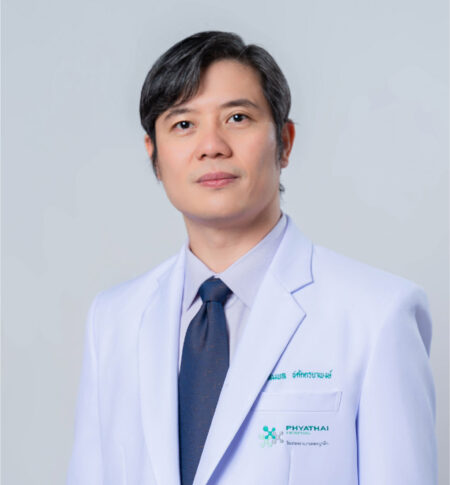
Dr. Panthanit Traithaned
Patients under the care of Dr. Panthanit Traithaned may present with various characteristics. If it is a group seeking treatment for headaches and dizziness, it is predominantly composed of working-age individuals, ranging from approximately 25 to 50 years old. On the other hand, patients with cerebrovascular diseases or stroke are commonly found in the age group of 60-70 years, often having underlying health conditions. However, there is an increasing trend of such diseases being detected in younger age groups.
After completing her medical degree from the Faculty of Medicine, Prince of Songkla University, and serving as a physician in Pattani province, Dr. Panthanit pursued further studies in neurology at Chulalongkorn University in 2012. She shared her inspiration and experiences during her studies:
“I became interested in and chose to further my studies in this field because I believe the brain and the nervous system are fascinating. The brain acts as a control center for various functions in our body. Neurological diseases are challenging to diagnose and treat, be it headaches, dizziness, or other conditions. Especially when patients have chronic and persistent symptoms that do not improve even after medication, it becomes even more challenging to find the cause and diagnose conditions related to brain blood vessels, which are at risk of causing strokes. Therefore, thorough and rapid examinations and treatments are essential to ensure the best possible quality of life for patients with minimal brain damage.”
As the heart of neurological and nervous system medicine, patients under Dr. Panthanit’s care vary in characteristics. Those seeking treatment for headaches and dizziness are typically within the working-age group, ranging from approximately 25 to 50 years old. On the other hand, patients with cerebrovascular diseases or stroke are commonly found in the age group of 60-70 years, often having underlying health conditions. However, there is an increasing trend of such diseases being detected in younger age groups.
“Because the brain is an internal organ within the skull, we cannot see it with the naked eye or easily examine it. Therefore, a detailed medical history is crucial, including when the event occurred or what symptoms the patient experienced before or after the illness. This information is vital for doctors to consider what disease the patient might have, where it might be located, and what further examinations are needed. Information from the medical history and physical examination is used together to analyze, diagnose, and, if necessary, order additional tests to confirm our initial diagnosis accurately and clearly.”
Rapid Diagnosis with Prepared Tools Enables Swift Treatment
Rapid diagnosis is of great importance in brain-related diseases. When Dr. Panthanit performs preliminary examinations and finds it necessary to conduct further tests using various tools, she can order them immediately. These may include examinations with tools such as Computed Tomography (CT Scan) and Magnetic Resonance Imaging (MRI), which have seen significant developments allowing doctors to see intricate details in the brain, identify signs of diseases, and pinpoint areas that require immediate attention. Apart from the examining doctors, hospitals are also equipped with medical professionals from different fields, including radiological technologists and physiotherapists, who play a role in caring for patients.
“The most crucial aspect is the attention to patients’ medical histories, along with the expertise and experience of the medical professionals, especially when it comes to patients with brain vessel issues. If severe symptoms are left untreated for more than 4.5 hours from their onset, it could lead to cerebral infarction or even death. Hence, swift diagnosis and team collaboration by medical professionals in hospitals enhance the treatment’s effectiveness, ensuring that patients receive timely medication or other appropriate treatments, even if it’s been more than 4.5 hours since the symptoms appeared.”
When abnormal symptoms are detected, seek medical attention promptly. For generally healthy individuals, Dr. Panthanit usually advises maintaining a balanced diet with the appropriate proportions of the five food groups and engaging in regular physical activity, amounting to at least 150 minutes per week. For individuals aged 35 and above, annual health screenings are recommended.
“Diseases related to brain vessels often show no warning signs. When patients experience abnormal symptoms, it indicates that the disease has already manifested. The best approach is regular health check-ups to reduce the occurrence of brain vessel diseases. Check blood pressure, cholesterol levels, and blood sugar (diabetes) regularly. Obesity is another risk factor for brain vessel diseases, so quitting smoking or reducing tobacco consumption is essential since it poses a similar risk.”
For individuals who already exhibit symptoms of the disease, it is crucial to immediately visit a hospital because the most important factor in treating this disease is to see a doctor as soon as possible. The faster the patient arrives at the hospital, the easier the treatment process will be, as the patient will receive timely treatment according to the appropriate stages of the disease.









